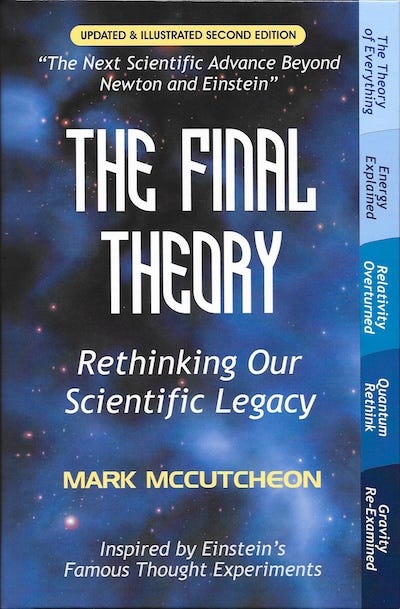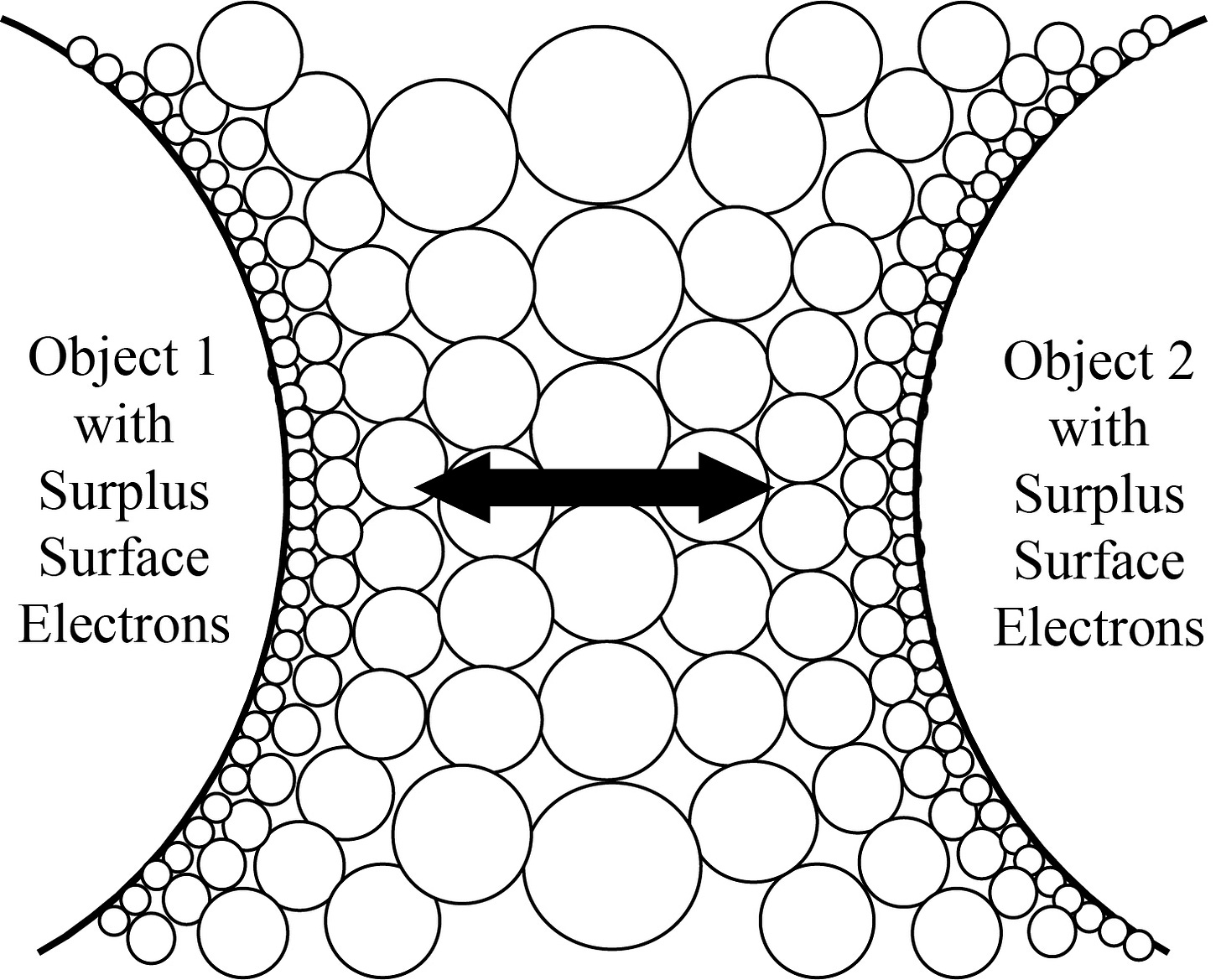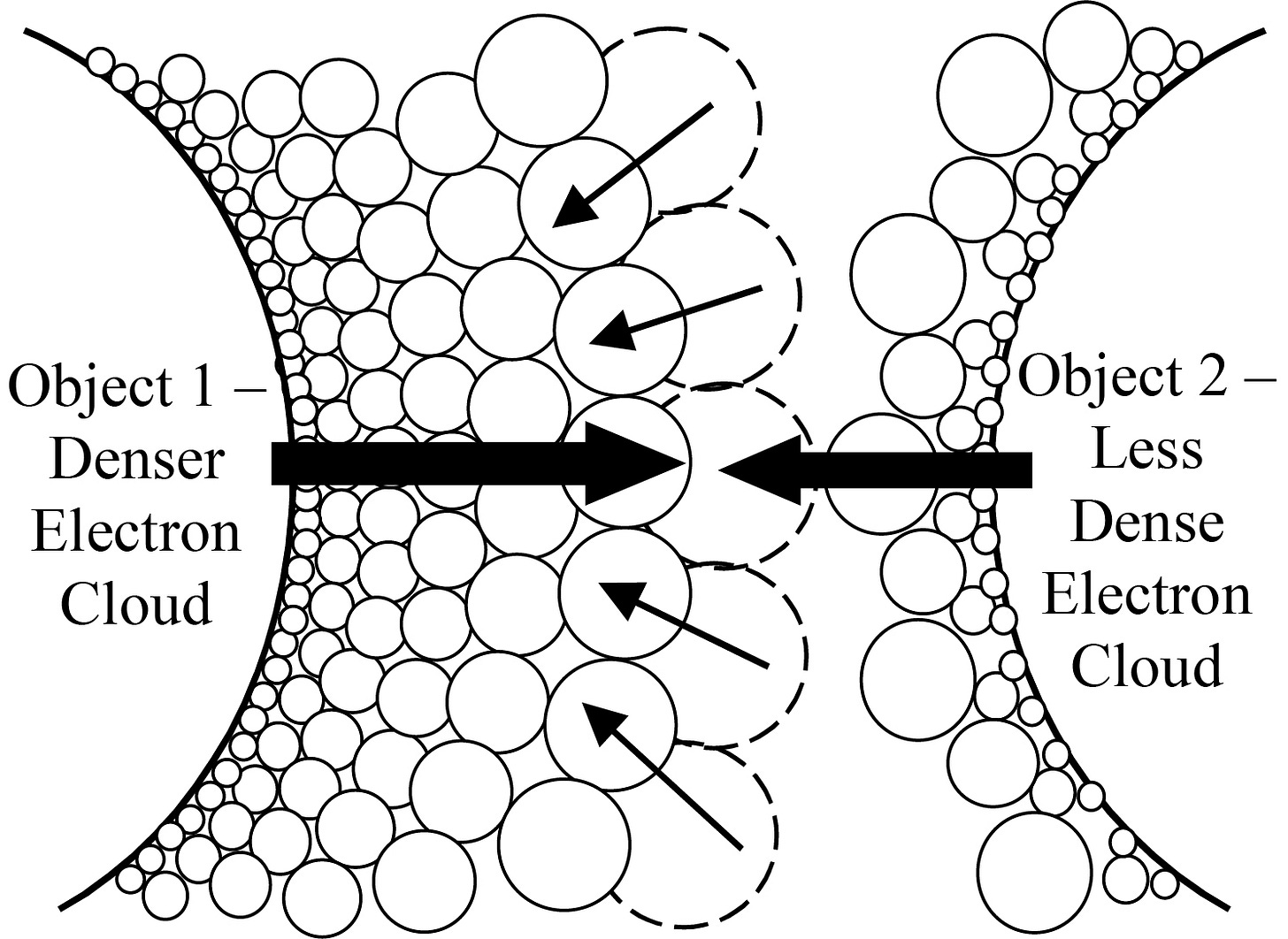3.7 Second type of growth and shrinkage of matter - The Crossover Effect - Static electricity (no paywall)
The Final Theory by Mark McCutcheon - Theory of Everything in Physics (5 of 13)
3.7 Second type of growth and shrinkage of matter - The Crossover Effect - Static electricity
In Atomic Expansion Theory, we finally have an answer to this phenomenon of static electricity, and it is not the same as gravity. Everything can now be explained through the simple expansion of electrons and subatomic particles, which are now solely made of electrons; and the expansion of atoms and any object, which are all made of atoms linked together into molecules. There are no more charges in Atomic Expansion Theory. But then, how can particles attract and repel each other? Let’s study Benjamin Franklin’s electrical attraction experiment in figure 5:
In the Benjamin Franklin’s “Electric Charge” experiment, he used two rods, one of glass and one of plastic (or wax in the original experiment). He then rubbed them with silk to make the glass rod positively charged, and the plastic rod negatively charged. And when suspended next to each other, the rods attracted each other. And if he used two glass rods and rub them with silk, they were both positively charged, and when suspended next to each other, they repelled each other.
Put very simply, while Mark McCutcheon explains this over several pages in his book, when you rub a rod of glass with silk, you create a surplus of electrons on the surface of the rod. This cloud of electrons, depending on its density, meaning how many electrons there are and how spaced out they are, will start to externalise out of the subatomic realm at a slow growing rate, to the outside where they start to grow freely and greatly. This is called the crossover effect.
Please note that in the crossover effect, we use the terms growing and shrinking instead of expansion, to make the distinction with the inner expansion of the electrons, which is constant behind the scenes (first type of expansion of matter). It is unrelated to electrons growing or shrinking when moving from the subatomic realm to the outside, or from the outside back into the subatomic realm (second type of growth and shrinkage of matter).
I must point out here that for me, the inner expansion rate of the electron is the same as the one of the atom. It would explain why a static field can remain immobile, while everything else around expands at a constant rate. However, for Mark, the expansion rate of the electron and all subatomic particles, XS, is much greater than the expansion rate of the atom, XA, and remains unknown.
This growing and shrinking rate of electrons is variable, while still in contact with the subatomic realm, and can even come to a stop, as we will see shortly. But once detached and left to grow freely into space, the expansion rate XS of subatomic particles and electrons becomes very high, which, while unknown, plays a role in defining the speed of light. This said, I define the speed of light differently, as I will explain later.
The significant difference between our diverging opinion, is that for Mark, the electron is always expanding at that rate XS, whether it is inside or outside the atom, and whether it is growing out or shrinking back within a static field. And why electrons don’t burst out from the atom, or from clouds of electrons in static fields, in their extreme inner expansion, is because the inside of the atom is a different foreign dimension not part of our reality. Our reality would be created by the atoms, and more specifically by the space created between the atoms.
The fact remains that, in a static electric field, electrons are outside the atom, and outside that foreign dimension, and so should immediately start to expand greatly at that inner expansion rate XS. In which case, the field could not remain static. The electrons would grow extremely fast compared with the atoms within the rods, and the distance could not remain the same. Therefore, I see no need for a foreign dimension within the atom, as soon as we consider the expansion rate of the subatomic particles and of the electrons, as being the same as the one of the atoms and the molecules.
As to how electrons can leave the atoms, if they don’t have a much higher inner expansion rate than the atoms, I feel that their growth when excited must be sufficient to kick them out of the atoms, whether they are bouncing, as Mark says, or orbiting, as I believe.
To return to our discussion, when you have two charged rods of glass with clouds of growing electrons of the same density, their expanding clouds of electrons will meet in the middle, growing against each other and repelling the rods. If left untouched, they could repel indefinitely, as seen in figure 6.
Both rods are pushed apart by a bridge of growing electrons in the form of a cloud, which is the definition of a magnetic field (electron clouds). There is still here an underlying expansion of the electrons, but it is unseen as we also expand. If it were not the case, a static field could not remain static or immobile for long, since everything else around us would overtake the field in size, and it would soon disappear from view.
When you present the glass rod with a denser cloud of expanding electrons on its surface, to a plastic rod with a less dense cloud of electrons on its surface, then the two clouds of electrons will meet closer to the object that has a less dense cloud of electrons on its surface.
When the expanding electrons on the glass rod meet with those of the less dense cloud of expanding electrons from the plastic rod, they start to shrink back into the subatomic realm, so the entire bridge of electrons seeks some sort of balance and equal size, which is the crossover effect. Then the objects are suddenly attracted to each other, as seen in figure 7.
You can move away the rods and move them back closer together, and the electrons in the bridge will grow and shrink back continually. But once the objects touch, that is it, you will see sparks and hear crackling. The bridge of electrons between the two objects will balance out and return to the subatomic realm, and some of these electrons will escape (sparks and crackling), and both objects will become neutrally charged, no longer attracting each other.
It is different when the two repelling glass rods with clouds of growing electrons of the same density finally touch. Here there is nothing to balance out, so they pretty much keep their expanding clouds of electrons or “repelling force”.
It is worth noting that this is why an object is no longer charged positively or negatively. Instead, it is all due to the behaviour of the electrons as growing and shrinking entities, pushing and pulling against each other in their search for balance. Here we have rods with clouds of a surplus of electrons of differing or equal density, and the crossover effect of the electrons between the subatomic world, where they grow slowly and regularly, and once freed outside the subatomic realm, where they grow freely and greatly.
Electrons grow slowly while they are in the subatomic realm, and they can stop growing altogether when two fronts of expanding electrons meet halfway between two rods of glass. They can start growing freely a great deal, once freed completely from the subatomic realm, to become light and heat for example, or magnetic fields. At that point, once completely freed from the subatomic realm, they are no longer growing, instead they are expanding freely into space. And they can also shrink back to the subatomic realm, when attracted back to it, because of a depletion of electrons in a certain area, or the attraction of a smaller or less dense cloud of electrons. All of this explains the attracting and the repelling forces in electromagnetism.
This is the crossover effect explaining the different behaviours of the electrons while in the subatomic realm (inside or just outside the atoms), or when outside the subatomic realm altogether, freely expanding into space, or in between: growing out, halting their growth, or shrinking back in.
Table of content (no paywall)
3.1 First and second types of expansion and contraction of matter according to Mark McCutcheon, concerning General Relativity and the four fundamental forces
3.2 Atomic Expansion Theory
3.3 New model of the atom, strong and weak nuclear forces and chemical bonds
3.4 Gravity and the formation of galaxies in Atomic Expansion Theory
3.5 Two types of distance decrease to calculate gravity in Atomic Expansion Theory
3.6 Atomic Expansion Equation to calculate gravity in Expansion Theory
3.6a The Atomic Expansion Equation
3.7 Second type of growth and shrinkage of matter - The Crossover Effect - Static electricity
3.8 Magnetism and Electricity in Atomic Expansion Theory
3.9 Energy in Atomic Expansion Theory
3.10 Motion and Orbits in Atomic Expansion Theory
3.11 Behind the scenes - Four different perspectives required to explain orbits and gravity
3.11a The first perspective - The God’s viewpoint with expansion - And can we change the expansion rate of matter?
3.11b The second perspective - Our resulting reality without expansion
3.11c The third perspective - Expansion re-established after the relative effects - And how orbits enlarge in spirals and naturally accelerate objects
3.11d Are orbits in the third perspective enlarging gradually or exponentially?
3.11e The fourth perspective - Objects passing each other in space if there were no expansion or gravity
3.12 Slingshot effect and other gravitational anomalies explained
3.13 Two best proofs of Atomic Expansion Theory - The levitating slinky and ball
3.13a The physics of a stretched suspended slinky being dropped
3.13b The physics of a suspended ball being dropped
3.14 Atomic Expansion Theory concepts and orbit simulations on YouTube
3.14a Cruz deWilde
3.14b Life, Everything And The Universe
3.14c The late Gerald Clark’s series about gravity featuring an interview with Roland Michel Tremblay, which are also on YouTube
3.14d Gerald Clark’s Premium Content requiring subscription, except for the free ones indicated
3.14e Chris Freely (The Cosmic Fool)
3.14f Ian Moore (Ianto)
3.15 Standard Theory and Atomic Expansion Theory Maps
Download New Age Physics Free Chapters:
Book PDF, Docx PDF, DOCX, Kindle ePub, Kindle Mobi, Apple Books, Nook, Google Play, Kobo, Generic ePub






